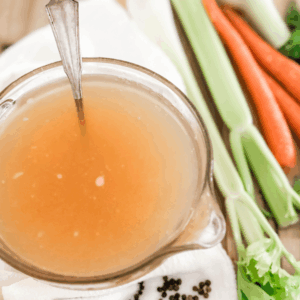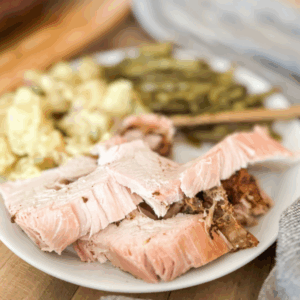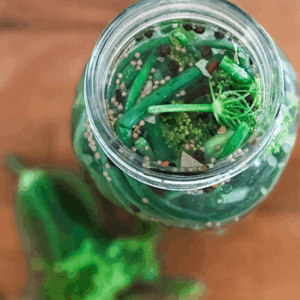How to Can Green Beans: Step-by-Step Instructions

This post may contain affiliate links, which means I make a small commission at no extra cost to you.
See my full disclosure here.
I learned how to can green beans three summers ago. It gets a little better every time, but every time I use my pressure canner, I’m pretty sure I’m about to blow up the entire house. Or at least the kitchen.
The Secret to Successful Canning
This year, even though I still felt a need to slather myself in calming essential oils during the procedure, I finally felt like I (sort of) knew what I was doing.
If there’s one thing I’ve learned in my few years of canning experience, it’s this:
- have ALL your supplies ready to go
- follow clear, step-by-step instructions
Okay, that was actually two things. But they’re equally important. And when I say clear, step-by-step instructions, I’m sort of not talking about the Ball Blue Book.
I love that food preservation guide as much as the next canning queen, but I’ve discovered that key bits of information are scattered throughout the canning manual. When you’re a canning amateur, it is vitally important to have every step spelled out in one place.
- Wait, what does 1 inch head space mean?
- How much water was I supposed to put in the canner?
- Oops, I never boiled water to put in the jars!
- When do I add the weight thingie?
If you’re wondering how to can green beans with a pressure canner, you’ll find this list of step-by-step instructions super helpful.
And if your pressure canner is collecting dust in the basement because you’re too scared to give it a try, this is your year, my friend. It’s really pretty simple if you gather all the supplies ahead of time and follow these clear instructions.
How to Can Green Beans
Gather your supplies
- beans – about 1 1/2 pounds per quart jar
- unrefined sea salt
- colanders
- cutting board
- sharp knife
- compost pail or bowl to collect bean trimmings
- jar lifter
- magnetic lid wand
- bubble remover / headspace tool (or long skinny plastic spatula)
- large ladle
- wide-mouth funnel
- Ball wide mouth canning jars – approx. one jar per 1 1/2 pounds of beans
- brand new flat canning lids – included when you purchase new jars
- screw on metal bands – included when you purchase new jars
- large flat tray or cutting board lined with a folded dishtowel
- clean, damp rag
- apron
- clean dishtowels
- 4 pots:
- pressure canner — After much research, I sprang for this all metal canner which uses no gaskets and will therefore cost less in the long run.
- small pan for heating jar lids
- medium to large pot of boiling water to ladle over the beans in the jars
- huge pot (a regular canning pot) for heating the jars OR plan to use the dishwasher — see below
How to Can Green Beans: Step-by-Step Instructions
First: Always allow several hours from start to finish, especially when you’re still learning. Make sure the kids are entertained, or better yet, gone. Fill up a huge glass of water for yourself and have easy meals or snacks prepared.
Believe me, you do not want to attempt lunch prep or dinner prep or putting little ones down for a nap in the middle of worrying about blowing up the kitchen.
I’m just kidding. You’re not going to blow up the kitchen. Just follow these step-by-step instructions and you’ll be golden.
- Put on your apron and sling a clean, dry towel over your shoulder. Do you feel official now?
- Decide on a method for cleaning and heating your jars. If the jars are already clean, they simply need to be heated. Heating the jars prior to canning will prevent breakage.
- If you have the stovetop space and a large enough pot (such as a boiling water canner), you can use it to submerge the jars in water to cover. Bring the water to a low simmer and keep the jars in the simmering water for at least ten minutes. Keep them simmering and remove one at a time as needed.
- Alternatively, you can run the jars through a regular dishwasher cycle. Leave them in the hot dishwasher and remove one at a time as needed.
- Add a small amount of water to a small pan–enough to cover the flat canning lids. Heat the water over low to medium-low heat. Do not boil. Add the lids and keep them at a very low simmer. Remove one at a time as needed .
- You’ll also need to boil water in a medium to large pot. This is the water you’ll ladle over the beans in their jars.
- Add about 2 inches of water to the pressure canner and insert canner rack. Heat water to a low simmer.
- Wash beans.
- Trim ends.
- Break or cut into 2-inch sections.
- When all the beans are cut into 2-inch sections, remove one hot jar.
- Pack one hot jar tightly with raw beans, leaving 1-inch headspace.

- Add 1 tsp unrefined sea salt per quart (1/2 tsp salt per pint).
- Ladle boiling water over beans, leaving 1-inch headspace.
- Remove air bubbles with a long, nonmetallic utensil like a narrow spatula.
- Wipe rim of jar with a clean, damp cloth.
- Remove one lid from the warm water, dry carefully and place on top of the jar. Add ring and adjust until secure but not as tight as you can make it.
- Place jar on canner rack immediately after filling.
- Repeat steps 8-15 for each jar.
- When the pressure canner is filled to capacity with jars (usually 7 quarts or 19 pints), lock the lid securely in place.
- Do not add the weight yet.
- Turn heat to medium-high and watch the steam flowing from the vent pipe. When it begins to flow steadily, set the timer for 10 minutes.
- When steam has escaped from the vent pipe for 10 minutes, add the weight on the vent pipe.
- Watch the pressure gauge. It should pressurize within about 5 minutes. For green beans, allow the pressure to reach 10 pounds.
- When the gauge shows 10 pounds of pressure, adjust the heat to maintain 10 pounds of pressure for the entire processing period. (20 minutes for pint jars; 25 minutes for quarts)
- After the appropriate processing period, turn off the heat. Let the canner cool naturally. Do not remove the weight or touch the lid until pressure returns to zero.
- When pressure returns to zero, remove the weight or open the petcock. Allow the canner to cool for 10 minutes more before removing the lid.
- Unlock the lid and lift it from the pot, being very careful to allow the steam to escape away from you.
- Allow the canner to cool for 10 more minutes before removing jars.
- Use the jar lifter to remove each jar from the pot, placing them on the tray or board lined with a dry towel.
- Leave an inch or two of space between each jar. Don’t touch the lids.
- Allow jars to cool naturally for 12 to 24 hours before testing the seals.
- To test the seals, press down in the middle of the flat lid. If it does not budge, that’s a good sign! To make sure, remove the metal band and gently pull up on the flat lid with your fingers. If it’s sealed properly, you won’t be able to break the seal with your fingers. Replace the metal band and transfer to a cool, dry, dark storage spot. Ideally, the temperature should remain between 50° and 70° F.
- Be sure to label your jars with the name and date. It’s best to eat canned beans within a year or less.
- Any jars that did not seal properly should be stored in the fridge or freezer, or eaten within a normal time range.
- If jars did not seal properly, the beans can be reprocessed. Click here for reprocessing instructions.
For printable instructions, see below.
Print
How to Can Green Beans: Step-by-Step Instructions
Description
You can do it! I promise you will not blow up the kitchen with your pressure canner if you follow these simple instructions.
Ingredients
- beans – about 1 1/2 pounds per quart jar
- unrefined sea salt
- colanders
- cutting board
- sharp knife
- compost pail or bowl to collect bean trimmings
- jar lifter
- magnetic lid wand
- bubble remover / headspace tool (or long skinny plastic spatula)
- large ladle
- wide mouth funnel
- Ball wide mouth canning jars – approx. one jar per 1 1/2 pounds of beans
- brand new flat canning lids – included when you purchase new jars
- screw on metal bands – included when you purchase new jars
- large flat tray or cutting board lined with a folded dishtowel
- clean, damp rag
- apron
- clean dishtowels
4 pots:
- pressure canner — After much research, I sprang for this all metal canner which uses no gaskets and will therefore cost less in the long run.
- small pan for heating jar lids
- medium to large pot of boiling water to ladle over the beans in the jars
- huge pot (a regular canning pot) for heating the jars OR plan to use the dishwasher — see below
Instructions
- Put on your apron and sling a clean, dry towel over your shoulder. Do you feel official now?
- Decide on a method for cleaning and heating your jars. If the jars are already clean, they simply need to be heated. Heating the jars prior to canning will prevent breakage.
–If you have the stovetop space and a large enough pot (such as a boiling water canner), you can use it to submerge the jars in water to cover. Bring the water to a low simmer and keep the jars in the simmering water for at least ten minutes. Keep them simmering and remove one at a time as needed.
–Alternatively, you can run the jars through a regular dishwasher cycle. Leave them in the hot dishwasher and remove one at a time as needed. - Add a small amount of water to a small pan–enough to cover the flat canning lids. Heat the water over low to medium-low heat. Do not boil. Add the lids and keep them at a very low simmer. Remove one at a time as needed .
- You’ll also need to boil water in a medium to large pot. This is the water you’ll ladle over the beans in their jars.
- Add about 2 inches of water to the pressure canner and insert canner rack. Heat water to a low simmer.
- Wash beans.
- Trim ends.
- Break or cut into 2-inch sections.
- When all the beans are cut into 2-inch sections, remove one hot jar.
- Pack one hot jar tightly with raw beans, leaving 1-inch headspace.
- Add 1 teaspoon unrefined sea salt per quart (1/2 teaspoon salt per pint).
- Ladle boiling water over beans, leaving 1-inch headspace.
- Remove air bubbles with a long, nonmetallic utensil like a narrow spatula.
- Wipe rim of jar with a clean, damp cloth.
- Remove one lid from the warm water, dry carefully and place on top of the jar. Add ring and adjust until secure but not as tight as you can make it.
- Place jar on canner rack immediately after filling.
- Repeat steps 8-15 for each jar.
- When the pressure canner is filled to capacity with jars (usually 7 quarts or 19 pints), lock the lid securely in place.
- Do not add the weight yet.
- Turn heat to medium-high and watch the steam flowing from the vent pipe. When it begins to flow steadily, set the timer for 10 minutes.
- When steam has escaped from the vent pipe for 10 minutes, add the weight on the vent pipe.
- Watch the pressure gauge. It should pressurize within about 5 minutes. For green beans, allow the pressure to reach 10 pounds.
- When the gauge shows 10 pounds of pressure, adjust the heat to maintain 10 pounds of pressure for the entire processing period. (20 minutes for pint jars; 25 minutes for quarts)
- After the appropriate processing period, turn off the heat. Let the canner cool naturally. Do not remove the weight or touch the lid until pressure returns to zero.
- When pressure returns to zero, remove the weight or open the petcock. Allow the canner to cool for 10 minutes more before removing the lid.
- Unlock the lid and lift it from the pot, being very careful to allow the steam to escape away from you.
- Allow the canner to cool for 10 more minutes before removing jars.
- Use the jar lifter to remove each jar from the pot, placing them on the tray or board lined with a dry towel.
- Leave an inch or two of space between each jar. Don’t touch the lids.
- Allow jars to cool naturally for 12 to 24 hours before testing the seals.
- To test the seals, press down in the middle of the flat lid. If it does not budge, that’s a good sign! To make sure, remove the metal band and gently pull up on the flat lid with your fingers. If it’s sealed properly, you won’t be able to break the seal with your fingers. Replace the metal band and transfer to a cool, dry, dark storage spot. Ideally, the temperature should remain between 50° and 70° F.
- Be sure to label your jars with the name and date. It’s best to eat canned beans within a year or less.
- Any jars that did not seal properly should be stored in the fridge or freezer, or eaten within a normal time range.
- If jars did not seal properly, the beans can be reprocessed.
Notes
- Click here to shop my favorite kitchen tools and real food ingredients.
- Click here to save 15% off my favorite, healthy brand of salt. Use code KEEPITREAL.
22 NOURISHING GLUTEN-FREE SOUP RECIPES
Simplify your dinner prep with these tasty, nourishing soups!

Sign up NOW for my best tips delivered weekly to your inbox!
You’ll also get instant access to my library of free ebooks and resources.











Leave a Comment